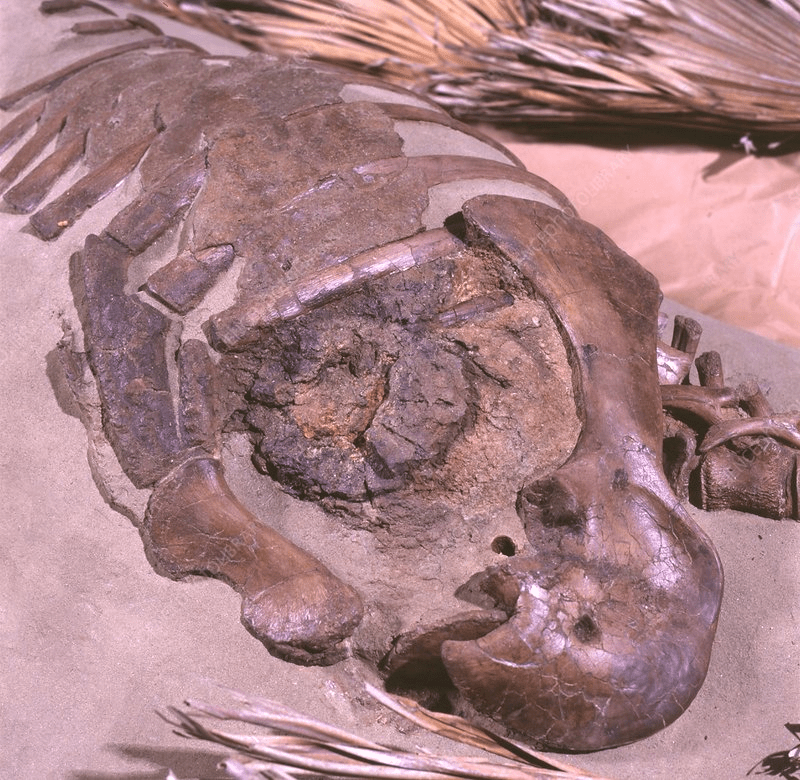Happy Valentine’s Day to those who celebrate! Or, to be more accommodating to an audience reading about dinosaurs today, those that don’t celebrate!
Yes, for as much as Valentine’s Day is associated with love and companionship, it is also known for loneliness and depression. How fun to be single on Valentine’s, reading about paleontology on your laptop or phone alongside a comforting bowl of ice cream (I jest in good faith, for I am one of these poor souls too). While dinosaurs weren’t experiencing emotions (good and bad!) on Valentine’s the same way we do, one curious case does exist of paleontologists breaking a dinosaur’s heart.
Let’s start at the beginning. In 1993, fossil preparator Michael Hammer excavated the skeleton of a relatively small dinosaur from the Late-Cretaceous aged Hell Creek Formation of South Dakota. In 1996, the North Carolina Museum of Natural Sciences (NCSM) purchased the specimen for a sum disclosed at 350,000 American dollars[i]. While this may seem like a lot of money, it pales to the costs of other fossils, such as a skeleton of T. rex that sold for a whopping $31.8 million in 2020.

In the coming years, researchers from the NCSM began to examine the fossil. They found that the fossil belonged to Thescelosaurus neglectus, a 4-meter-long bipedal herbivore that lived alongside famous dinosaurs like Triceratops and T. rex. The specimen, informally known as “Willo,” consisted of a near-perfect skull alongside most of the post-cranial skeleton. While the skull would later prove essential for understanding the taxonomy of Thescelosaurus[ii], another element caught the eyes of paleontologists: a small mineral concretion lodged within the ribcage.
At first, a research team led by Paul Fisher and Dale Russell believed the structure may contain additional fossil material[iii]. In order to confirm this without damaging both the concretion and potential fossils, the team utilized CT scans to peer within. What they found was surprising: the mass appeared to be a heart, complete with four chambers and an aorta[iv]. The team hypothesized that the concretion was formed by iron-bound ions released shortly after her death. The release of large ion quantities interacted with the groundwater surrounding the heart, thus creating a protective barrier that later mineralized to form the concretion observed[v].

Not only was this a rare specimen, but also one that seemed to add further evidence that dinosaurs possessed hearts incredibly similar to birds. This finding suggested that even dinosaurs distantly related to birds, like the Ornithischian Thescelosaurus, had warm-blooded metabolisms. The discovery seemed too good to be true, which, if you could guess by the existence of this article, it was.
Doubts about the study’s validity emerged almost immediately. A 2001 paper refuted the notion that the concretion contained a heart, citing discrepancies in the anatomy and positioning of the structure[vi]. As paleontologists Timothy Rowe, Earle McBride, and Paul Sereno would note: “Ironstone concretions are notorious for producing suggestive and misleading shapes[vii]”. To them, the shape of a fossil heart was a misinterpretation from hopeful paleontologists looking to strike gold.
Their doubts would be confirmed in 2011 when a new study utilizing multiple imaging technologies found no evidence of the structure being a heart[viii]. Instead, they found that sand and other particles had percolated into the chest cavity of Willo, forming a concretion that only superficially resembled a heart. At that moment, Willo’s heart became broken forever.

Luckily for Willo, her excellent preservation prevented her from fading into paleontological oblivion. A 2023 study has proposed that Thescelosaurus may have been a burrower based primarily on examining Willo’s brain anatomy (For more information, read the following link!). Though her heart became broken many years ago, the paleontologists now overseeing her at the NCSM are teaching her to love again.
Thank you for reading this article! While the heart of Willo was a mere mirage, a fossilized heart has been discovered before. In 2022, the heart of a 380-million-year-old armoured fish was described, making it the oldest known in the fossil record! To learn more about this incredible discovery, read it here at Max’s Blogosaurus.
I do not take credit for any image found in this article. All images come courtesy of the individuals tagged below or under each respective image.
Header image courtesy of Taylor McCoy, found here.
Works Cited
[i] Dalton, Rex. “Doubts Grow Over Discovery of Fossilized ‘Dinosaur Heart.’” Nature, vol. 407, no. 6802, Springer Science and Business Media LLC, Sept. 2000, pp. 275–76. Crossref, https://doi.org/10.1038/35030365.
[ii] Boyd, Clint A. “The Cranial Anatomy of the Neornithischian dinosaur Thescelosaurus Neglectus.” PeerJ, vol. 2, PeerJ, Nov. 2014, p. e669. Crossref, https://doi.org/10.7717/peerj.669.
[iii] Fisher, Paul E., et al. “Cardiovascular Evidence for an Intermediate or Higher Metabolic Rate in an Ornithischian Dinosaur.” Science, vol. 288, no. 5465, American Association for the Advancement of Science (AAAS), Apr. 2000, pp. 503–05. Crossref, https://doi.org/10.1126/science.288.5465.503.
[iv] Black, Riley. “Willo the Dinosaur Loses Heart.” Smithsonian Magazine, 17 Nov. 2013, http://www.smithsonianmag.com/science-nature/willo-the-dinosaur-loses-heart-93712793.
[v] Boyd, Clint. “The ‘Overlooked Marvelous Reptile.’” Department of Mineral Resources, North Dakota, Jan. 2016. https://www.dmr.nd.gov/ndgs/documents/newsletter/2016Winter/The%20Overlooked%20Marvelous%20Reptile.pdf
[vi] Rowe, Timothy, et al. “Dinosaur With a Heart of Stone.” Science, vol. 291, no. 5505, American Association for the Advancement of Science (AAAS), Feb. 2001, pp. 783–783. Crossref, https://doi.org/10.1126/science.291.5505.783a.
[vii] See above.
[viii] Cleland, Timothy P., et al. “Histological, Chemical, and Morphological Reexamination of the ‘Heart’ of a Small Late Cretaceous Thescelosaurus.” Naturwissenschaften, vol. 98, no. 3, Springer Science and Business Media LLC, Jan. 2011, pp. 203–11. Crossref, https://doi.org/10.1007/s00114-010-0760-1.